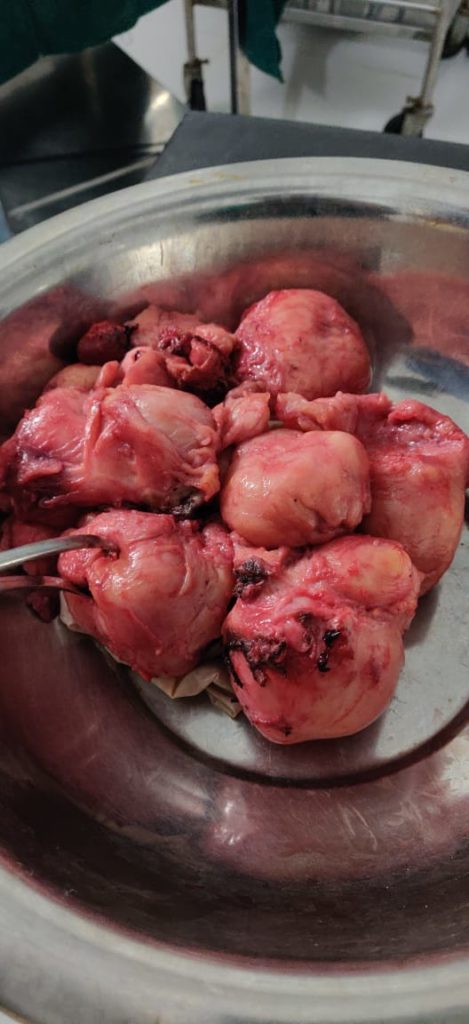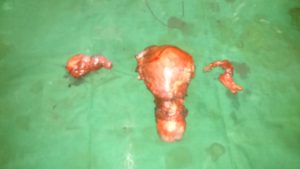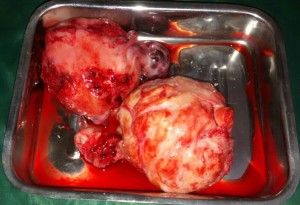Pages
Categories
Archives
Meta
A total laparoscopic hysterectomy was performed at meenakshiamma hospital ,on a lady with a uterus as big as a 7 month pregnant lady’s. Surgery went uneventful . Post operative period was uneventful. Patient was discharged on the very next day after surgery .
Patient was diagnosed with multiple fibroids in the uterus and was advised hysterectomy . She had severe menstrual cramps and excessive bleeding due to the same . She was refused laparoscopic surgery at couple of hospitals due to the huge size of the uterus . For the same reason she has been delaying the surgery for more than 3 years . Finally now ,she is out of her problems and we see a happy patient .
A case of Bad obstetric history
18/01/19
Here’s the story of a lady who had lost a young baby years back.
She was a 41 year old lady. 10 years back she conceived after infertility treatment and delivered a male baby, in a different hospital. It was a premature delivery as patient had preterm labour pains at 6th month of pregnancy. The baby was under NICU care for 3 months in view of prematurity and was discharged after 2 months of NICU care. At home ,following discharge baby died due to a suspected infection!
After this patient tried for conception for a good long 9 years, but was in vain. Then she consulted Dr Vinay Chandra shenoy , a renowned infertologist at Payyanur. Following a successful treatment under him patient conceived. Patient came to us for further ANC and was managed by Dr Muralikirshnan nambiar and Dr Shyamala mukundan.
We were curious to find out the reason for her previous premature delivery . On evaluation she was found to have chronic urinary tract infection (infections are notorious in causing preterm deliveries) which was resistant to treatment. So we started the patient on what we call “suppressive prophylaxis for UTI” to which she responded well and this prevented any further UTIs. To prevent a second premature delivery , we put a cervical encerclage at 14 weeks.
Next thing we were curious about was the reason behind her previous new born death. We evaluated her and found her to be positive for toxoplasmosis. We started her on Spiramycin and continued through pregnancy.
We also excluded probability of Downs syndrome in the baby after doing relevant tests. Pregnancy was followed with strict vigil as she had marginally raised sugars and BP was on the higher side.
Finally we come to the happy ending. After Patient delivered a healthy male baby weighing 3.2kgs. Both mother and baby was discharged and sent home in healthy condition. Now the baby is 6 months old and doing fine. Never lose hope, believe in destiny.
We proudly announce the successful completion of the first total laparoscopic hysterectomy at Meenakshiamma memorial hospital, Payyanur, Kerala. The patient came to us with complaints of a mass protruding from vagina and heavy menstrual bleeding. On examination there was an elongated uterus (the cervix was elongated and protruding below the vagina).The uterus was enlarged to a size as big as that of a 16 weeks pregnant lady. We performed a total laparoscopic hysterectomy with right ovariectomy with B/L salpingectomy on her.
Now , what did we do different in her ? We did the whole surgery laparoscopically , ie , through just 3 key holes(5mm). Even the vault was sutured laparoscopically. There was no surgical manipulation from vaginal end. So what advantages does this offer the patient? The whole surgery was completed without any stitches (except a single stitch at the vault) which means there won’t be any kind of perioperative pain following surgery. The chances of infection are near zero. This requires just a single night stay at the hospital. The patient got discharged from the hospital the very next day following surgery. She joined her regular work after one day. Use of laparoscopy also powers you to remove the fallopian tubes without damaging the ovaries. This prevents any risk of ovarian cancer in the future.
How does this make it any different from other laparoscopic hysterectomies? So far the surgeons around have been performing vaginal , abdominal or laparoscopy assisted vaginal hysterectomy(LAVH). LAVH means laparoscopy is used to help you perform a vaginal hysterectomy. Here as many as forty (40) stitches are used to complete the surgery. In this the patient may experience post operative pain, needs rest just like any other surgery.
In a nutshell , every patient should enjoy the benefit of laparoscopic surgery, the advantages being complete absence of pain following surgery, single night hospital stay, allows you to join routine work immediately, prevents any risk of ovarian cancer in future (as fallopian tubes are removed)
Recent hysterectomy at our hospital
09/06/15
Dr shyamala mukundan recently performed a hysterectomy on a patient at our hospital with menorrhagia (excessive bleeding during periods). The patient had a huge fibroid (enlargement of uterine muscles in to a mass)measuring about 14x13cm. The surgery which takes highly challenging skills took about 4.5 hours to be completed . First myomectomy was performed followed by removal of uterus. The fibroid weighed about 1.3 kg.The patient is recovering in our hospital following the surgery and will be discharged soon .



